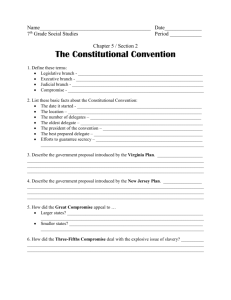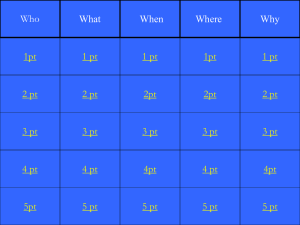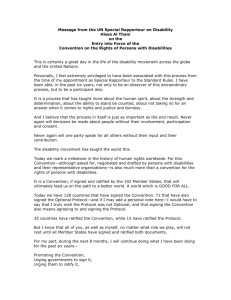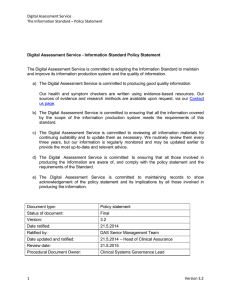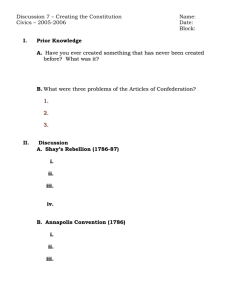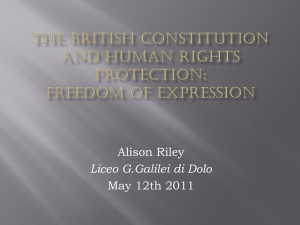Document 11963726
advertisement
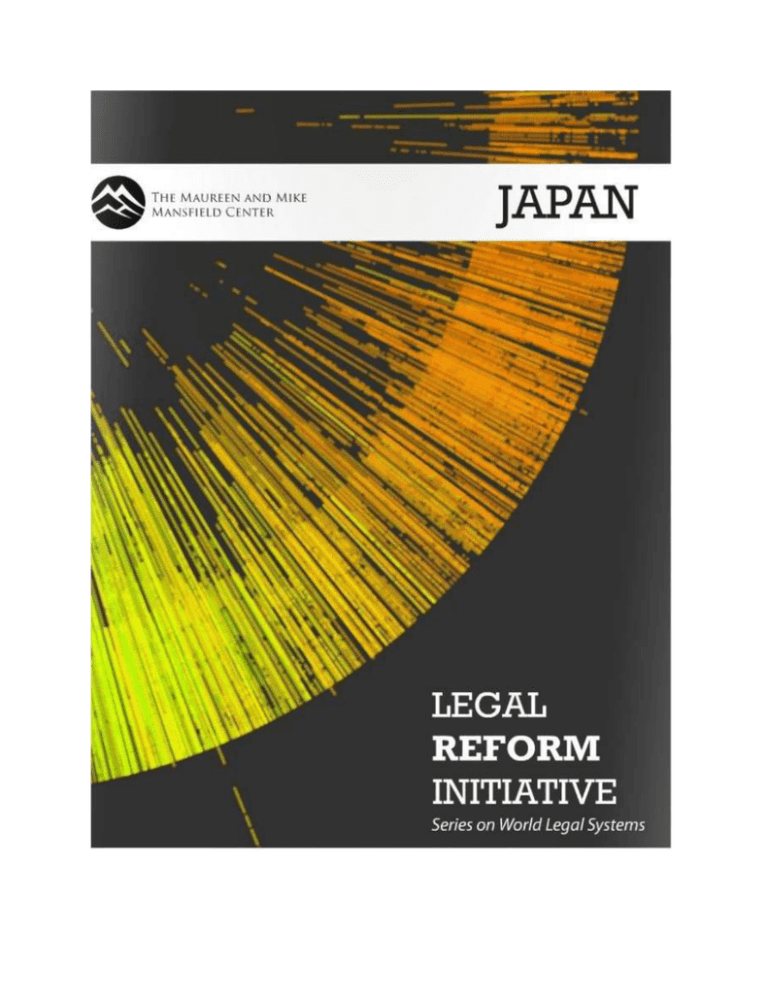
JAPAN CONSTITUTION Japan’s Constitution was drafted during the Allied occupation of Japan following the Second World War. After surrender, Japan was very reluctant to draft a new Constitution to replace the previous Constitution of the Empire of Japan, Meiji, enacted in 1890. Japan’s first attempt at a post-war constitution was rejected by General Douglas MacArthur, who oversaw the occupation of Japan until 1951. Two officers with legal training on MacArthur’s staff drafted much of Japan’s Constitution. Japanese lawyers, leaders and legislators reviewed and revised the Constitution before its adoption and enactment on May 3, 1947. Unlike many Constitutions, the document has not been amended since its drafting. The Japanese Constitution is sometimes referred to as the “Peace Constitution” because Japan officially renounces war in Chapter 2, Article 9: “Aspiring sincerely to an international peace based on justice and order, the Japanese people forever renounce war as a sovereign right of the nation and the threat or use of force as means of settling international disputes. (2) In order to accomplish the aim of the preceding paragraph, land, sea, and air forces, as well as other war potential, will never be maintained. The right of belligerency of the state will not be recognized.” Today, Japan does have armed forces, but they are maintained for the self-defense of Japan, rather than for any offensive purpose. Japan’s Constitution establishes a parliamentary democracy. Chapter 3 of the Constitution provides features of a democracy, such as free speech, freedom of religion and thought, fundamental human rights, and the rights of life, liberty and the pursuit of happiness. EXECUTIVE BRANCH While the Emperor is the Head of State in Japan, executive power is vested in Japan’s Prime Minister and Cabinet. After the end of World War Two, the Emperor’s power became extremely limited and the position is now largely symbolic. The Prime Minister is formally appointed by the Emperor of Japan and selected by the National Diet. He serves as the Head of Government. In turn, the Prime Minister selects and appoints members of the Cabinet. Naoto Kan is the current Prime Minister, serving since 2010. Terms are four years long and if a new Prime Minister is selected, the election cycle yields a completely new Cabinet. LEGISLATIVE BODY Legislative authority in Japan is vested in the bicameral National Diet of Japan. The National Diet makes all the laws for Japan. Before the end of World War II, this power primarily rested with the Emperor. The upper house of the National Diet is the 242-member House of Councillors. The lower is the 480-member House of Representatives. Both houses are popularly elected by a parallel voting system. JUDICIAL SYSTEM The judicial system of Japan is an independent branch of government, an important check established after World War II. Most judges cannot be removed from the bench except for cases of infirmity or incapacity, but voters can remove a judge from the Supreme Court although this has never happened. The judicial system in Japan is four tiered: The lowest level and most prevalent courts in Japan are known as Summary Courts. Throughout the country, there are 438 Summary Courts presided over by a single judge. These local courts primarily hear civil cases, small claims, and minor crimes. These courts have limited ability to punish or imprison. Civil cases are appealed to the District Court and criminal cases are appealed to the High Court. The next level of court is the District Courts. There are 50 District Courts in Japan. Each of Japan’s 47 prefectures has a main District Court with local branches and Hokkaido, because of its size, has three. The District Courts are courts of general jurisdiction: they hear cases that are too large to be heard in small claims court, bankruptcies, and felonies. Cases in District Court are decided by three-judge panels. In 2009, Japan introduced the system of saiban-in for certain types of criminal cases. Under the saibanin system, lay members of the community sit with a panel of professional judges to hear the most serious criminal cases. Unlike the American jury system, the judges and the lay assessors work together throughout the case. The judges counsel the lay members on the applicable law, and the lay members and judges can deliberate through the entire proceedings, not just at the end of the case. Verdicts must be by a majority of the panel, but must include both a vote from one judge and at least one lay member. The District Courts also have a special division of Family Courts with more than 203 branch offices around the country. The Family Courts attempt to mediate domestic matters. If the cases cannot be resolved by mediation, the matter is transferred to the District Court. Japan’s High Courts cover several prefectures organized into circuits. There are eight circuit courts. The High Courts serve as appellate courts for cases appealed from the District Courts and criminal cases appealed from the Summary Courts. At the top of Japan’s judicial system is the Japanese Supreme Court. The Supreme Court interprets Japan’s Constitution. The Chief Justice and fourteen Justices are appointed by the Cabinet and approved by the Emperor. IMPLEMENTATION OF UNITED NATIONS COUNTER-TERRORISM RESOLUTIONS Japan has ratified thirteen of the sixteen United Nations international legal instruments against terrorism. Ratified Yet to be Ratified The Aircraft Convention: 1963 Convention on Offences and Certain Other Acts Committed on Board Aircraft Ratified: May 26, 1970 The Unlawful Seizure Convention: 1970 Convention for the Suppression of Unlawful Seizure of Aircraft Ratified: April 19, 1971 The Civil Aviation Convention: 1971 Convention for the Suppression of Unlawful Acts against the Safety of Civil Aviation Ratified: June 12, 1974 The Diplomatic Agents Convention: 1973 Convention on the Prevention and Punishment of Crimes Against Internationally Protected Persons Ratified: June 8, 1987 Hostages Convention: 1979 International Convention against the Taking of Hostages Ratified: June 8, 1987 Nuclear Materials Convention: 1980 Convention on the Physical Protection of Nuclear Material Ratified: October 28, 1988 Airport Protocol and Montreal Convention on Air Safety: 1988 Protocol for the Suppression of Unlawful Acts of Violence at Airports Serving International Civil Aviation, supplementary to the Convention for the Suppression of Unlawful Acts against the Safety of Civil Aviation Ratified: April 24, 1998 2005 Protocol for the Suppression of Unlawful Acts against the safety of fixed platforms located on the Continental Shelf 2005 Amendment to the Convention on the Physical Protection of Nuclear Material 2005 Protocol to the Convention for the Suppression of Unlawful Acts against the Safety of Maritime Navigation Ratified Maritime Convention: 1988 Convention for the Suppression of Unlawful Acts against the Safety of Maritime Navigation and the 2005 Protocol to the Convention for the Suppression of Unlawful Acts against the Safety of Maritime Navigation Ratified: April 24, 1998 Fixed Platform Protocol: 1988 Protocol for the Suppression of Unlawful Acts Against the Safety of Fixed Platforms Located on the Continental Shelf and the 2005 Protocol to the Protocol for the Suppression of Unlawful Acts against the Safety of Fixed Platforms Located on the Continental Shelf Ratified: April 24, 1998 Plastic Explosives Convention: 1991 Convention on the Marking of Plastic Explosives for the Purpose of Detection Ratified: September 26, 1997 Terrorist Bombing Convention: 1997 International Convention for the Suppression of Terrorist Bombings Ratified: November 16, 2001 Terrorist Financing Convention: 1999 International Convention for the Suppression of the Financing of Terrorism Ratified: June 11, 2002 Nuclear Terrorism Convention: 2005 International Convention for the Suppression of Acts of Nuclear Terrorism Signed: September 2005 Ratified: August 3, 2007 Yet to be Ratified In addition, Japan is working to implement UN Resolutions 1373 and has made five reports to the United Nations Counter Terrorism Committee on the county’s progress. Most recently, in 2005 Japan reported concrete action in nine areas: immigration, aviation security, port and maritime security, customs cooperation, export control and non-proliferation, lawenforcement cooperation, combating financing of terrorism, counter-CBRN terrorism, counter-terrorism international conventions and protocols to further comply with Resolution 1373. Japan has not made a report since Resolution 1624 was promulgated by the United Nations Security Council. Japan reports that the country’s existing legislature largely addresses all of portions of Resolution 1373. Japan highlights the laws and procedures set up in their financial sector to combat money laundering, the financing of terrorism and the financing of organized crime. Japan is making further steps to increase port security and security of container shipping and implemented the Container Security Initiative. CORRUPTION AND GOVERNANCE Japan is one of the more highly-developed countries in the world. The Global Perceptions Index on Corruption ranked in 17th out of 178 counties. All of Japan’s governance indicators fall within the 75th to 90th percentile and have remained steady since 2003. However, nearly half of Japanese citizens view the country as increasingly corrupt with political parties perceived to be the most corrupt organization. Only 9% of Japanese citizens report bribing a public official in the past year.
